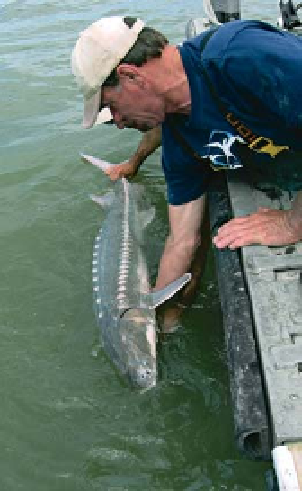Biology Reference
In-Depth Information
tracked the pings through the winter of 2008-2009. After running the data
through a new statistical model, Burau thinks they will find out not only
how many fish choose to take which routes but also how many survive
that choice. “We'll know route selection and survival probability for each
slough and channel within a few percentage points, which will help us
make better restoration and water management choices for the fish,” says
Burau. (For more details on salmon, see p. 173, “Last of the Fishing”; p.
184, in “Mini Guide: Species in Peril”; p. 219, “Water Rights for the Eco-
system”; p. 223, “Production or Conservation Hatcheries?”; and p. 228,
“Migrations: Two Salmon Travel Butte Creek.”)
Sturgeon
Sturgeon resemble their dinosaur-age ancestors more closely than any
other fish. Their most distinctive features include a long shovel nose, a
skeleton consisting largely of cartilage, and five rows of armored plates
called scutes that emerge from the skin on their backs. Drooping below a
sturgeon's mouth are four fleshy feelers, or
barbels
. Each is covered with
taste bud-like structures the fish uses to sense the presence of nearby
food. Sturgeon are so large and powerful that they can easily inflict broken
bones and bad cuts on fishermen and biologists who haul them on deck.
Sturgeon have been living in the Sacramento River system and travel-
ing into the bay for between two million and five million years. Two spe-
Biologist Rob Fairey examines a White
Sturgeon. Sturgeon have a storied life in
the annals of California literature. In the
crime novel
Dead Game
, author Kirk
Russell describes poachers keeping an
8-foot-long, 50-year-old sturgeon teth-
ered alive to a dock in a delta slough
until she could be winched out of the
water and sliced open for her ovaries.
The roe must come from a freshly killed
fish and be iced immediately to make
the caviar grade. These ancient and
magical fish can be seen at Pier 39's
Aquarium by the Bay. (William Jakl)


